It’s hard to believe it has been almost a year since I reviewed the 2019 Colt King Cobra! On the other hand, it’s also hard to believe it has only been a year since this special revolver came into my life! We try our dead-level best to give you guys the most honest, most thorough reviews we possibly can, but sometimes, there’s no substitute for time. Today I’m going to revisit the Colt King Cobra, and give you my thoughts after a year with this wheelgun.
I know this probably isn’t the Colt’s product you were hoping to read about this week. With my local range being closed I am doing what I can to get “the other” Colt revolver shot enough to have something to say, so stay tuned for that. This isn’t just filler, though. I have grown incredibly fond of this revolver and it has quickly become a range favorite, and a favorite in the holster around the house.
Then and Now
If you’ve read the original review I wrote, you know that I was pretty enthusiastic in my praise of the new .357 Magnum wheelgun from Colt. In fact, I don’t think it would be unfair to call that review “glowing.” Though I was extremely enthusiastic about the King Cobra at the time, there’s still a little anxiety around releasing such a positive review, so early in a gun’s life cycle. I’m sure we’ve all seen it with various firearms from all quarter – sometimes there are some early bugs that need to be worked out.
So where am I now with the King Cobra? I’m very happy to report that I still stand 100% by my review, and the King Cobra. In fact, I’ve come to look a bit more kindly on some of the complaints I lodged in that original review. Since the initial review I have a little better than tripled the round-count on this revolver. I’ve also gained some experience on some other Colt’s revolvers in that time, including a review of the King Cobra Target, and the beginnings of a Python review.
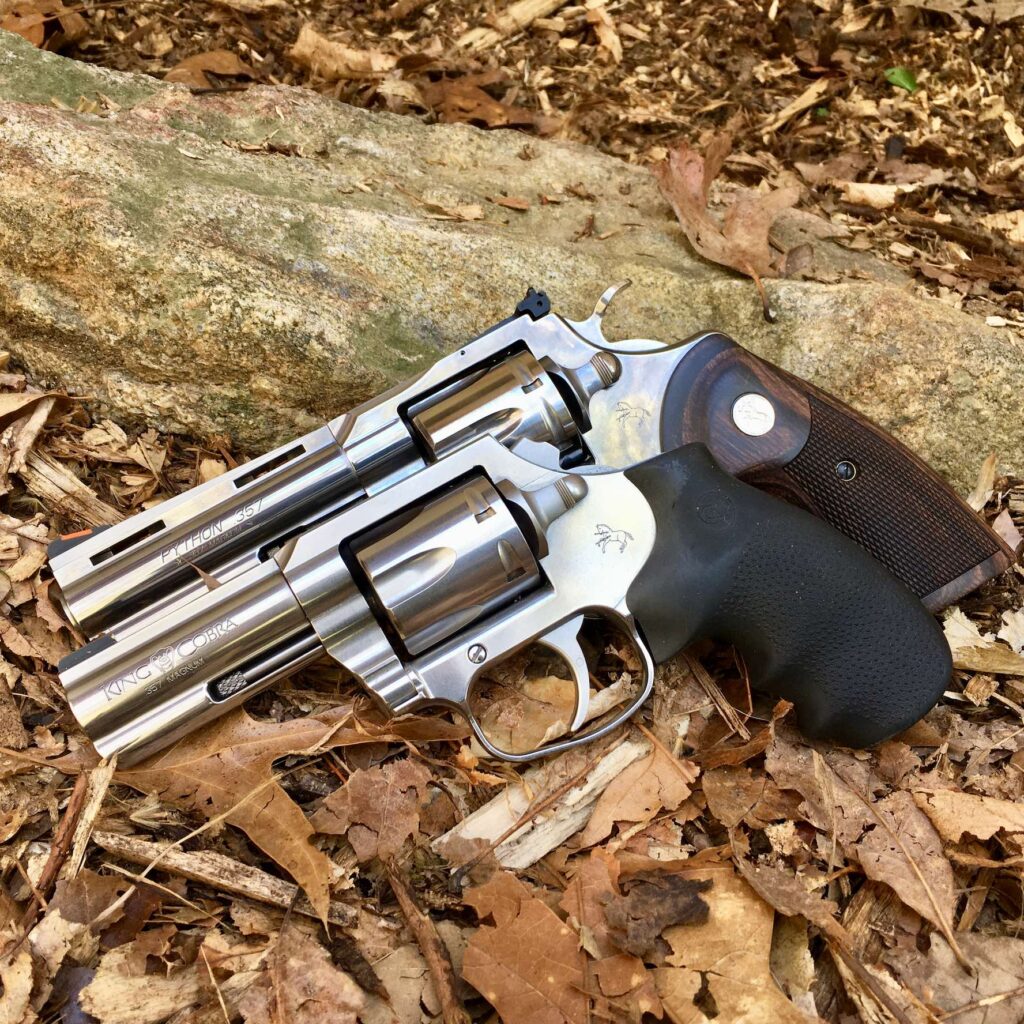
One thing I gave a lot of negative attention to was the trigger. First, I complained about its width, and this serves as an instructive example of how reviews with the best of intentions can sometimes be skewed. During a review I attempt to cram several years’ worth of interaction into a few months. This means I’m doing a lot more trigger time, over a very compressed time, than the average owner probably will. So back to that narrow trigger…
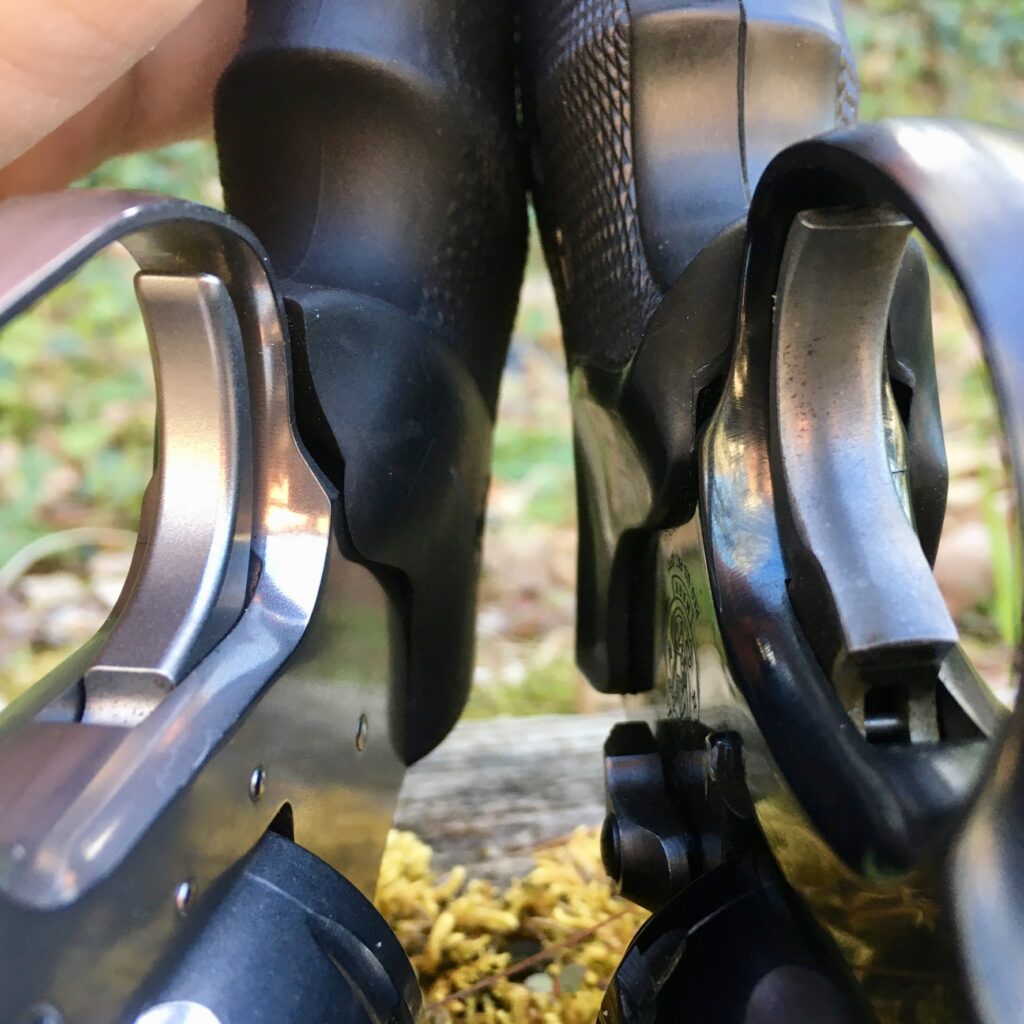
Honestly, I still wish it were wider. Even fairly short dry practice sessions with a lot of trigger pressing can become painful. However, it’s not bad for normal use where you’re taking lots of breaks. For, say, range sessions of 100-150 rounds in an hour or so it’s just fine. I even shot this gun at Greg Ellifritz’ revolver class to no ill effect.
The other thing I complained about was the trigger rebound. I believed it’s a little light and had some trigger “short stroking” issues. I’ve mostly excised that problem from my kinesthetic lexicon. I still thing the trigger rebound could be just a tiny big more positive, but the gun works and a dedicated practitioner can surely overcome this issue.
Modifications
You will also notice one modification, and probably miss another. The noticeable modification is the bobbing of the hammer. This hatchet-job is my handiwork. This gun is mean to be run in double action, so there really wasn’t a great reason to leave the hammer in place. One day I was sitting around, contemplating the cost of having a gunsmith bob the hammer, then thinking, “an awful lot of hammers have been bobbed at home.” I’ll be honest – I didn’t spend a lot of time thinking about it – I just got to work and got it done.
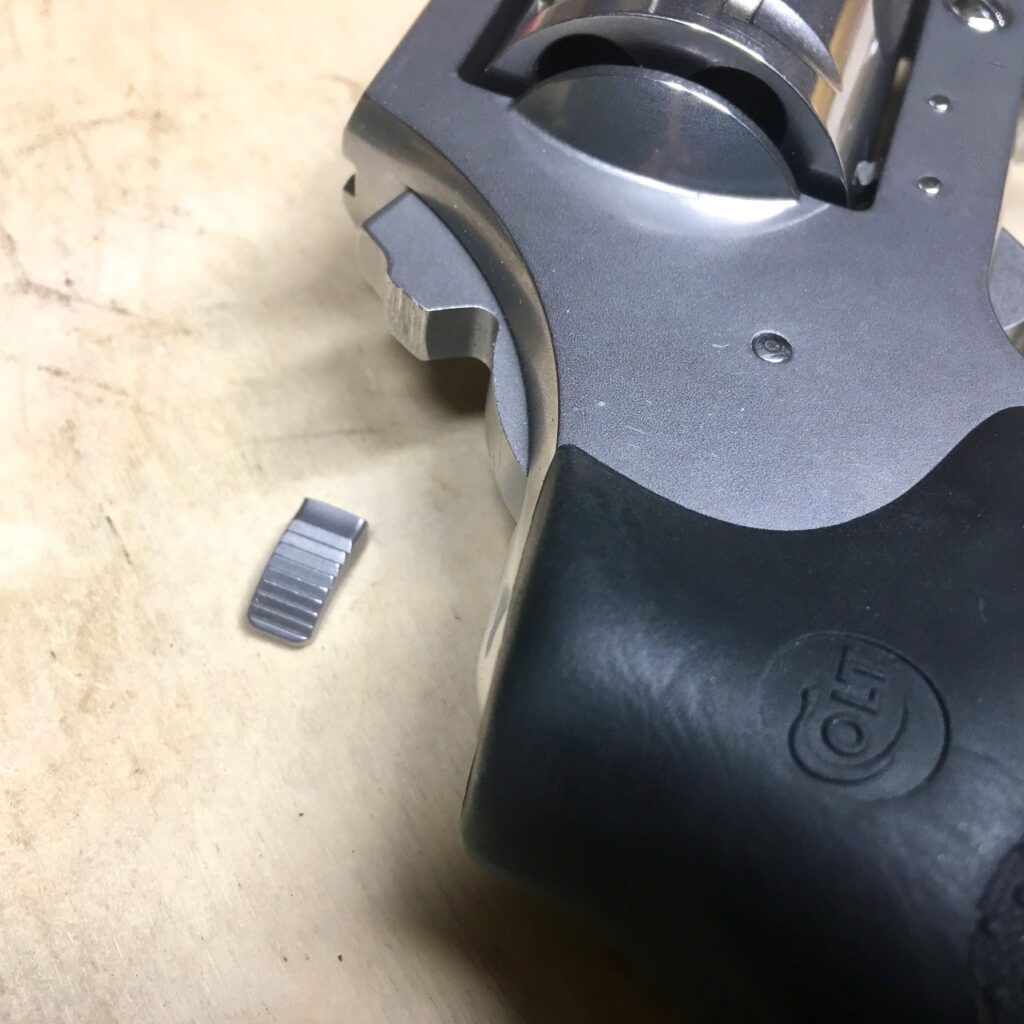
And I’m glad I did. Since bobbing the hammer I’ve put around 400 rounds on the gun, all of which have fired on the first strike. I also somewhat prefer the profile of the gun with the trimmed hammer as I wasn’t particularly fond of the hammer spur. The only downside to bobbing the hammer I see is the ability to “check” the hammer on holstering. It’s still there, but you have to get your thumb a little deeper because the spur is no longer there.
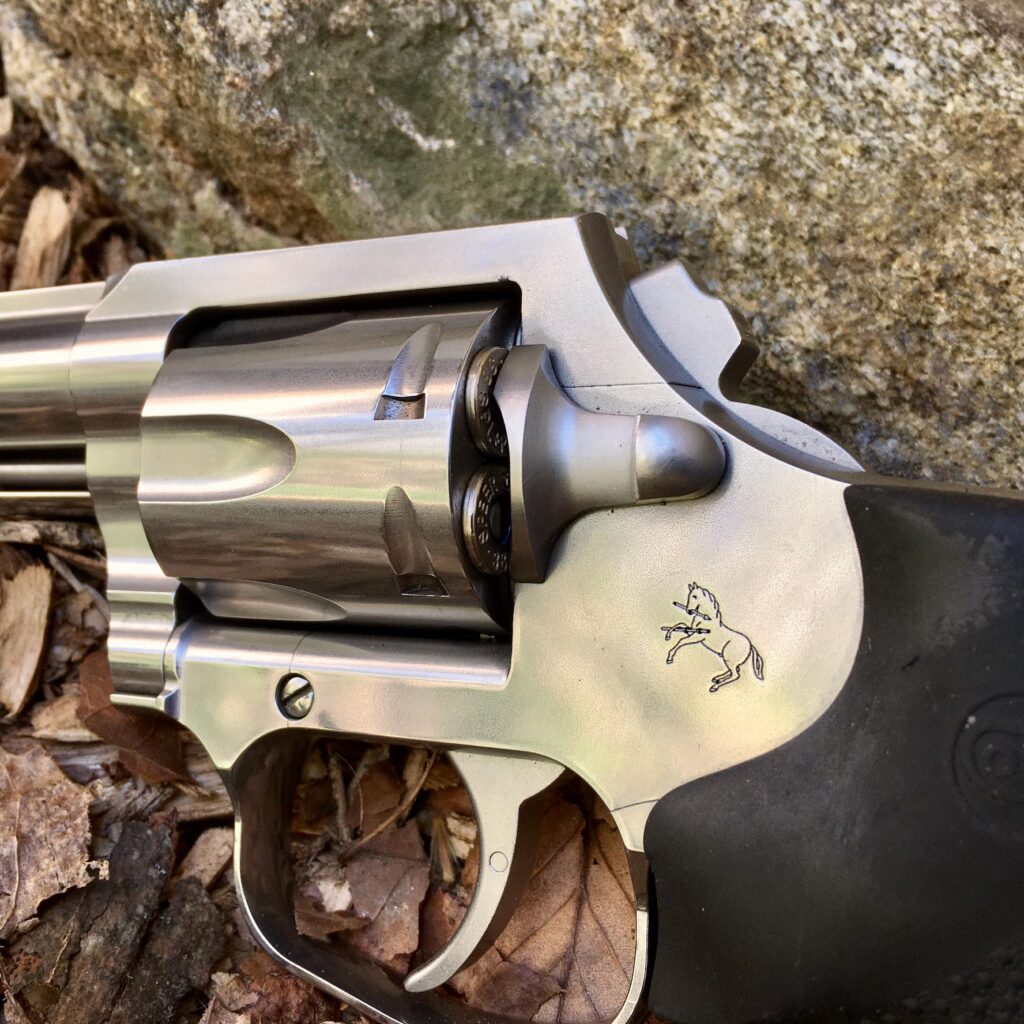
Wait – there is one more downside. Since I did this with hacksaw it’s not the pretties job. Honestly, though, I’m really not that particular about how my tools look as long as they work.
The second modification is the ejector rod. About six months into my ownership of this revolver I began to experience sticking of the ejector rod. The tip of the original rod wasn’t much larger in diameter than the channel on the yoke. As the knurling wore down it was possible to push it slightly into the channel, causing the rod to stick.
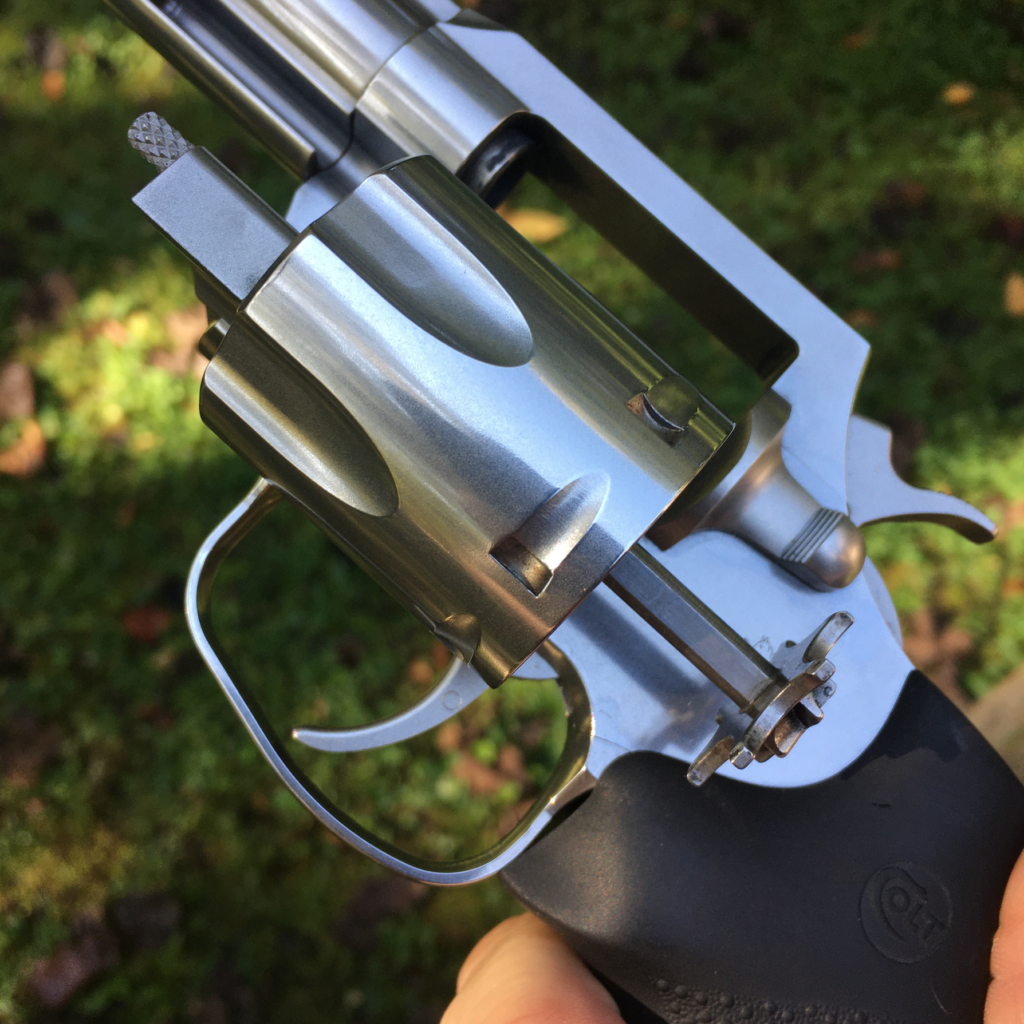
The first approach I took here was to simply file down the knurling. This worked perfectly, and I would recommend it without hesitation if you encounter the same issue. The knurling serves little functional purpose beyond allowing the user to tighten the ejector rod, so I had no problem filing it.
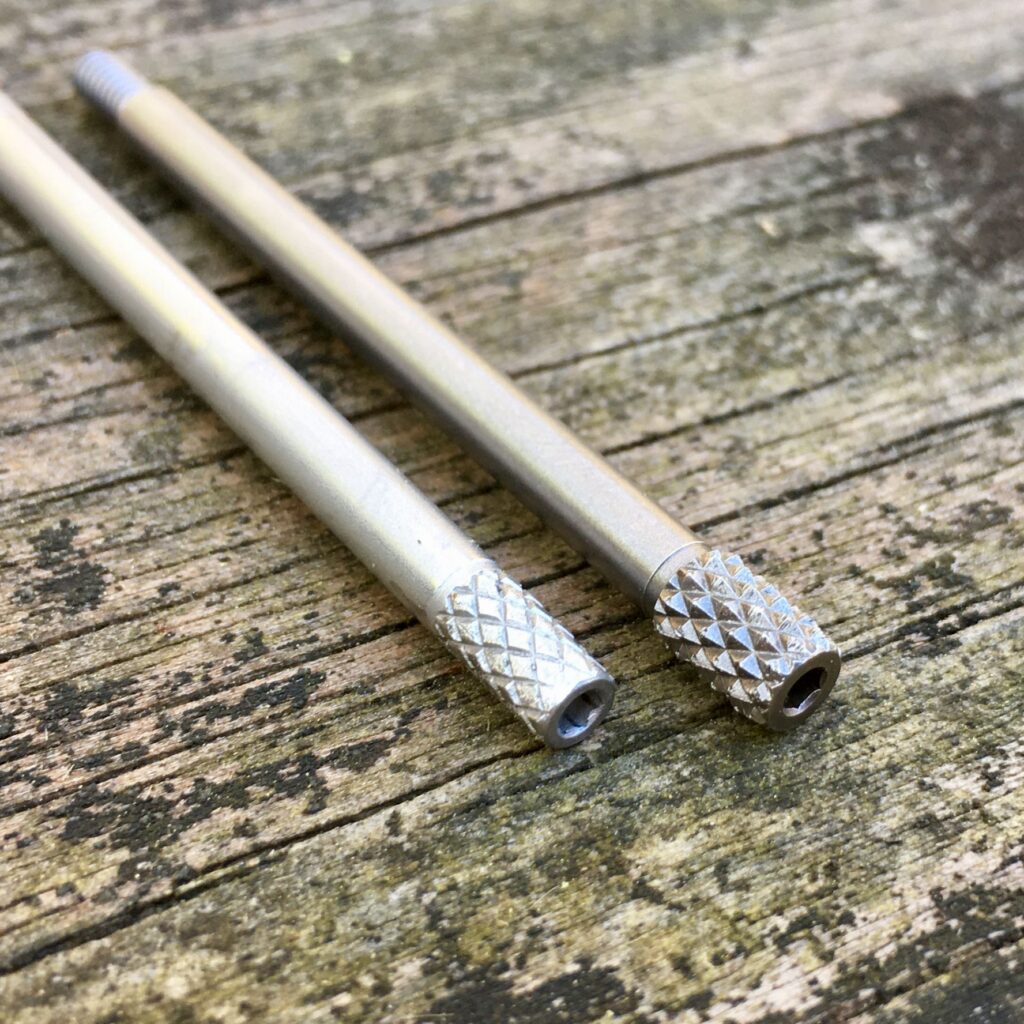
The second fix was a new ejector rod from Colt’s. Mike texted me from SHOT with a picture of the new rod. Apparently Colt’s has been listening to people (maybe including the crew here at RevolverGuy?) and improved the King Cobra’s ejector rod by increasing the diameter of the tip. I don’t have a ton of time with this part installed – only 150 rounds or so – but so far, so good. It is super refreshing to see a company like Colt’s being so responsive to the market!
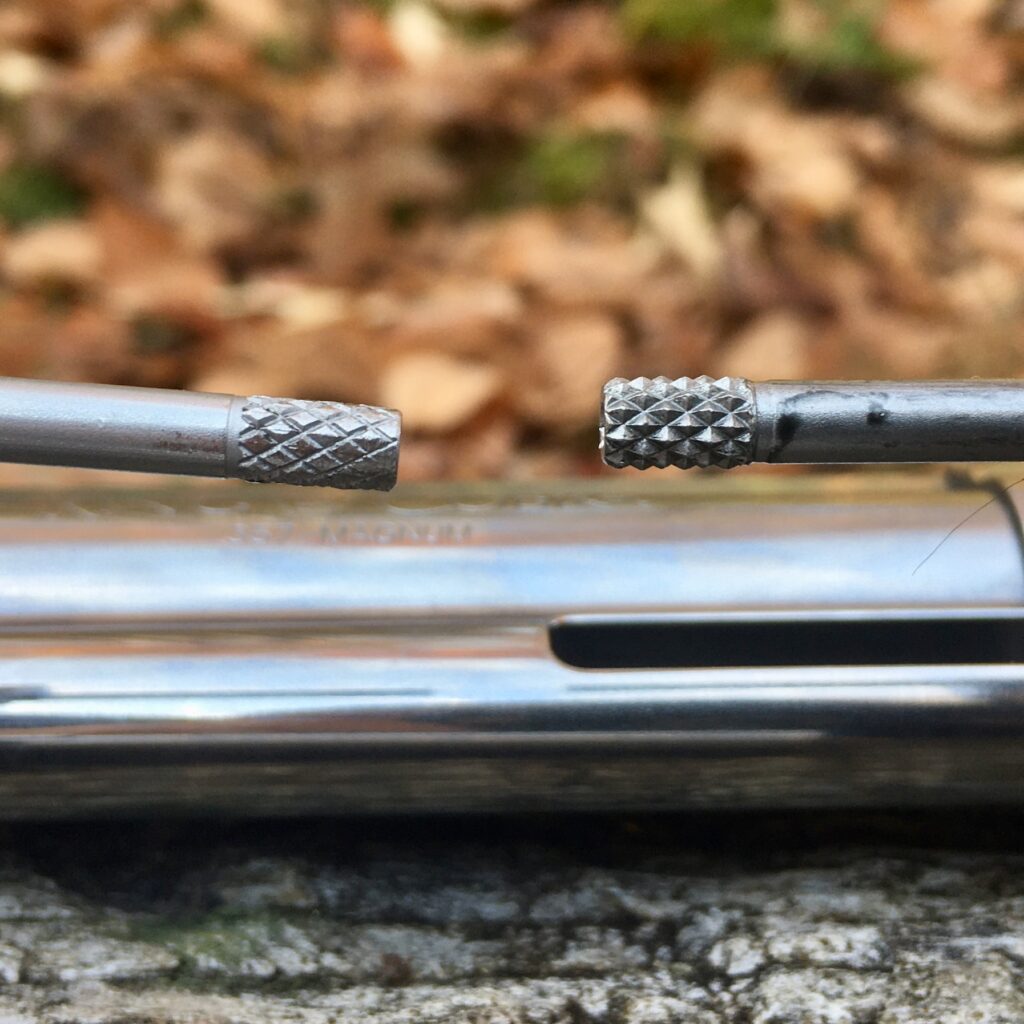
Speedloaders
Man, wringing out the speedloader issue for every revolver is becoming a tad tiring – everything seems to work with a different mix of loaders. If you follow the YouTube gun celebrities you might be aware of a recent kerfuffle between two of them about a video that showed some revolver shooting and reloading. The guy kicking the whole thing off said, essentially, “no one who knows anything would carry HKS loaders.” To be honest, I don’t disagree with him in principle; there are much, much better designs out there.
In reality, though, things are a little different. We RevolverGuys are wondering in the wilderness, not the land of milk and honey the Glock guys enjoy. As such, for a lot of revolvers its HKS or nothing. And that is the case with the King Cobra. I have found that HKS K-Frame speedloaders work pretty well, as long as you don’t try to seat the cartridges too deeply – the alignment is ever-so-slightly off. I’ve also found that the K-PAK from ZetaSix works, as well.
I’ve tried just about everything else I have. Unfortunately I don’t have an inline loader that works. I don’t own a K-Frame S.L. and it wouldn’t really matter if I did. The Jetloader doesn’t fit, nor does the Comp II, so for now it’s the HKS or nothing.
Size & Carry
Chris Baker wrote an article years ago calling the 3″ K-Frame the “Glock 19 of Revolvers.” I will assume he did so because his concept predated the Colt King Cobra. The size of the 3″ revolver is right in that sweet spot: small enough for comfortable, all-day carry, but large enough to really shoot (and speaking of shooting – man will this gun shoot!).
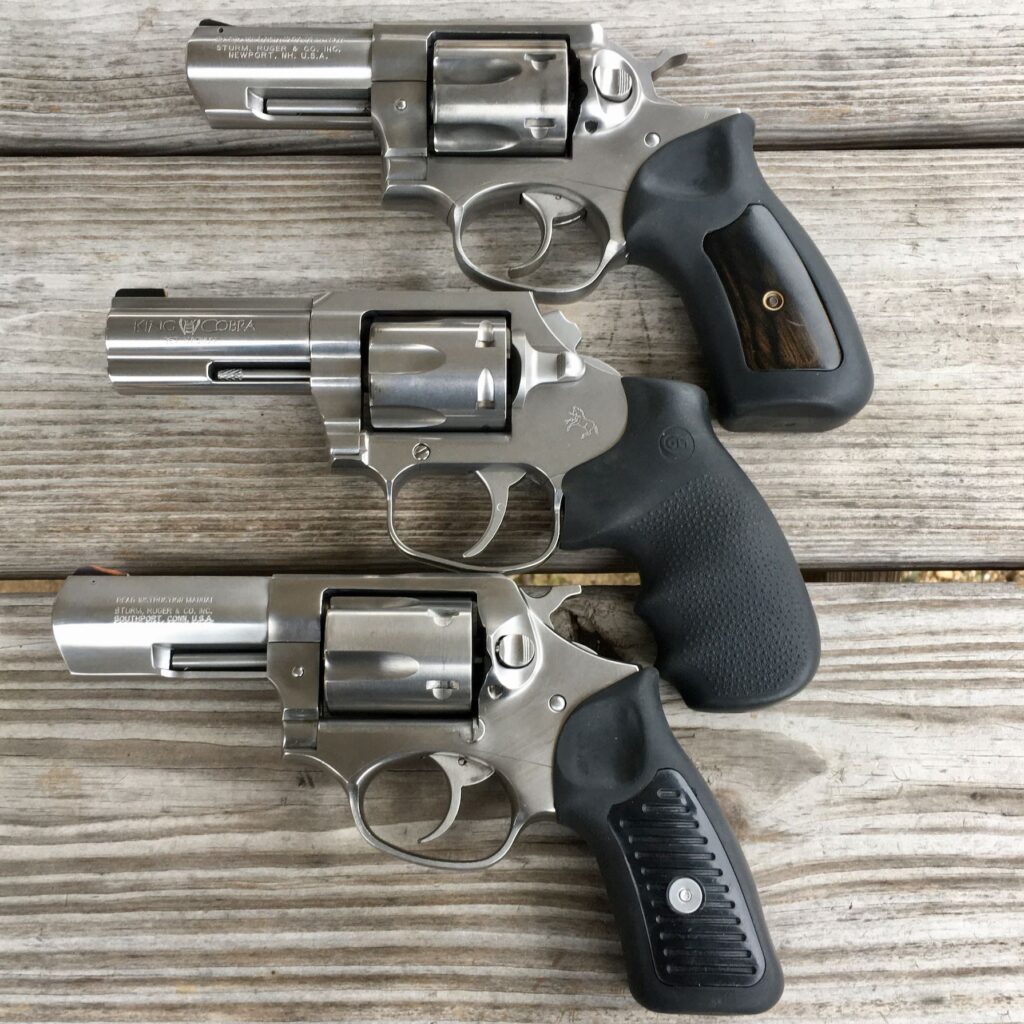
The grips do make the gun a bit larger than is absolutely necessary but I am happy to live with them. Though I’ve had the opportunity to replace them with some other style of grip it hasn’t even occurred to me. They are comfortable and fill my hand just about perfectly.
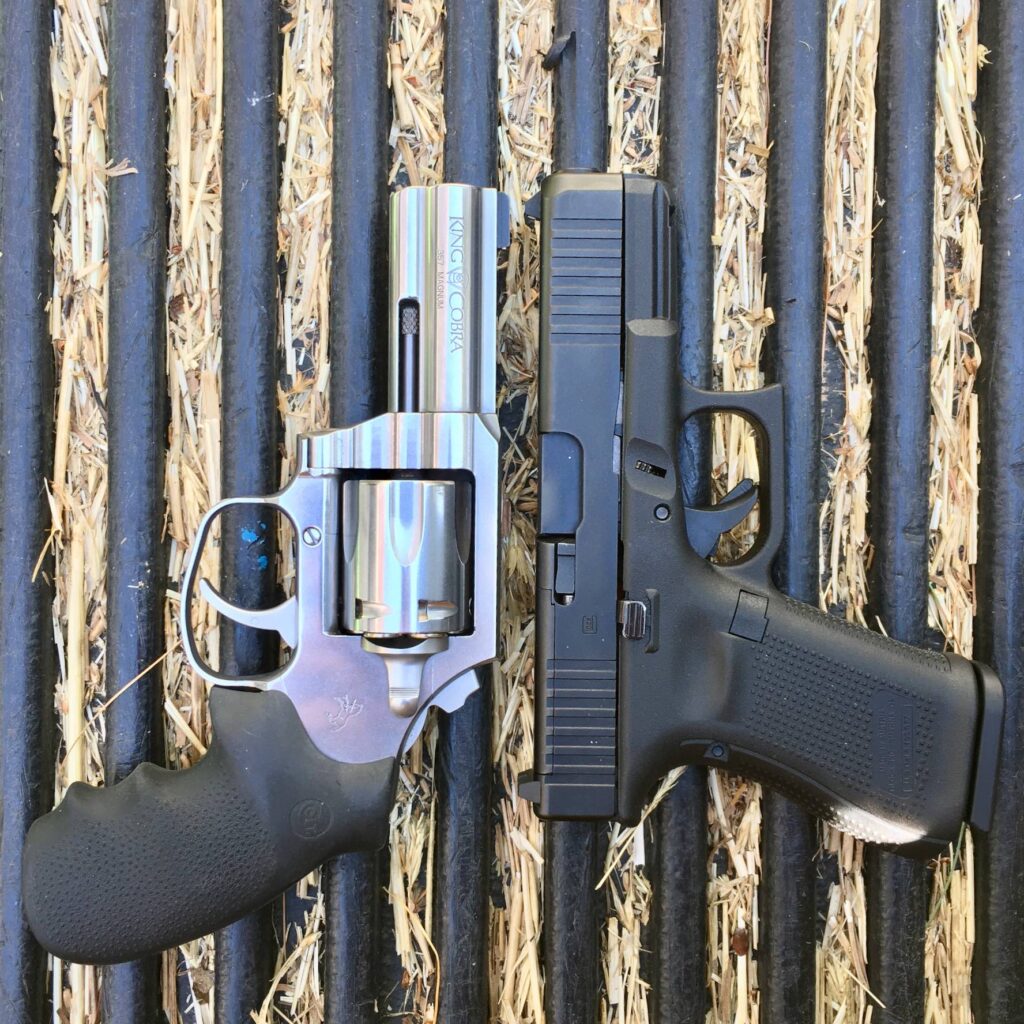
I have carried the. King Cobra a bit. Unfortunately holster fits have stymied my efforts a little. When I do carry the King Cobra it’s in the Kramer OWB holster I reviewed some months back. This holster is quite comfortable under a tool belt, and has a few scars now. I am on the hunt for a AIWB holster, but unfortunately haven’t found one yet. That (and a suitable speedloader) would be a game-changer for me.
The Bottom Line
I hope this didn’t just come across as me simply writing about something I like. I think the Colt King Cobra is about as good as a carry revolver gets: the ideal combination of size, weight, and excellent trigger, outstanding accuracy, and very usable sights. I don’t receive any incentive at all from Colt’s, I just want to share my own good fortune with you.
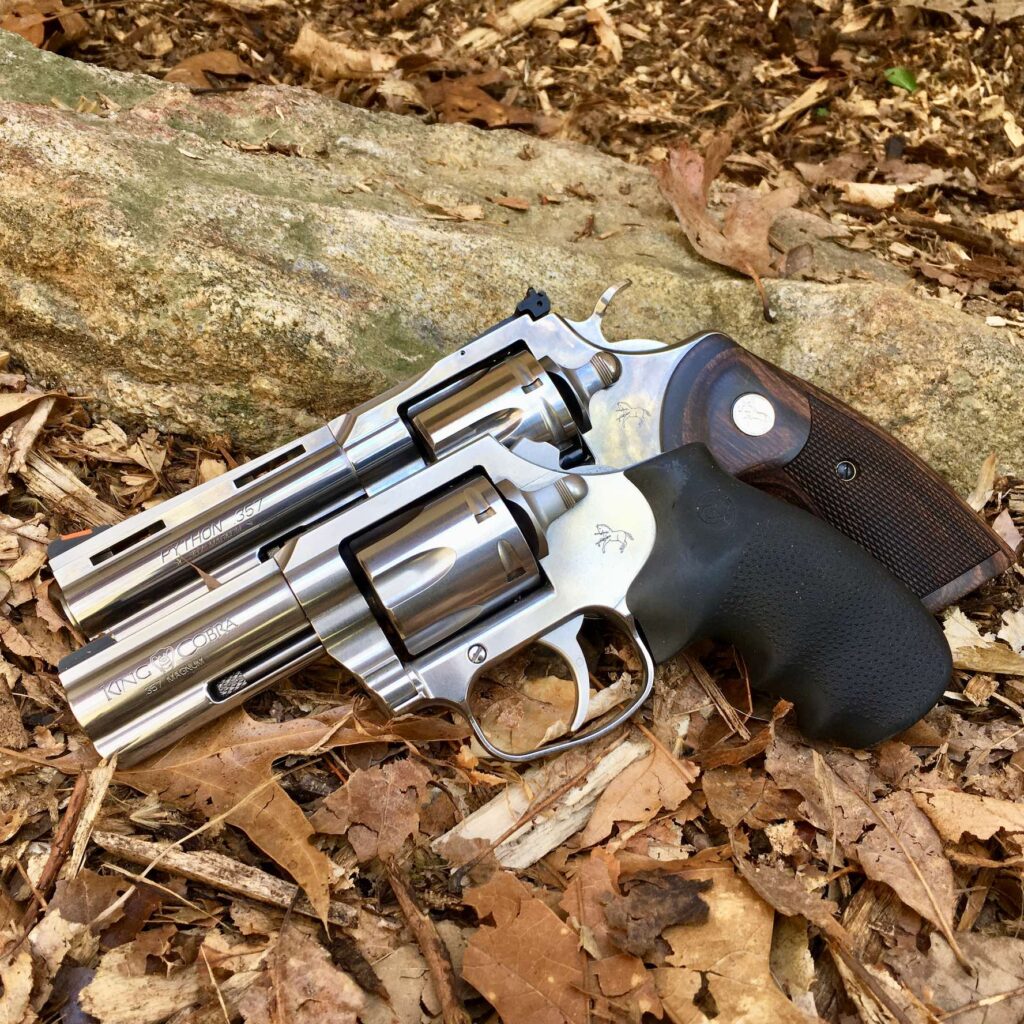
The King Cobra is somewhat hampered by the lack of aftermarket support – holsters and speedloaders. I’m going to keep beating this drum though: this revolver is The One and could almost replace both my 640 and my 686. If you’re interested in a revolver for carry, you owe it to yourself to check it out.

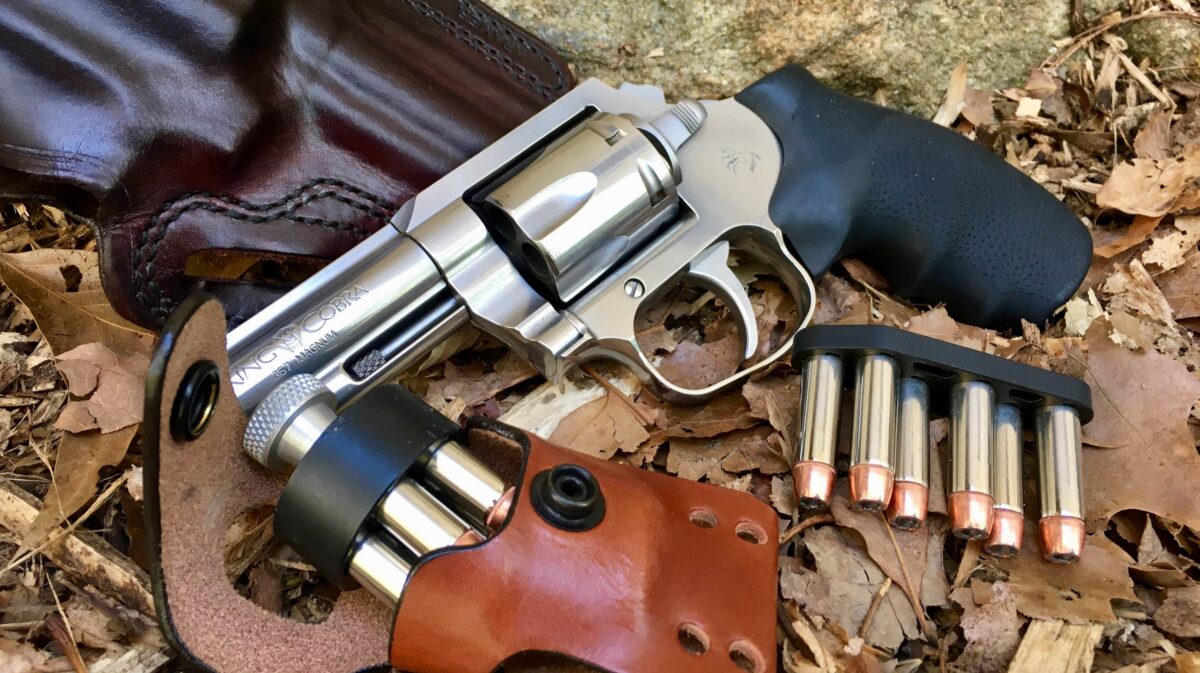
Comparison with the 3” Kimber K6S?
Justin, great article! Goldilocks is a good comparison. The King Cobra is not too big, not too small, but just right.
You might check out Jackson Leather. John Is in Concord, NC. He made a nice IWB for my GP 100. It an eight to ten week wait, but he does nice work.
Thanks for the update. Some guns are like Goldilocks’ verdict…not to big or too little but “just right!”
That is why I love the K-frame. Colt brought back a good size, since the S&W Ks are rather expensive now and have that lock.
My GP or, better yet, Blackhawk are great for .357 loads, but if you pack +p .38 or keep it in the house as we do, those guns are more “Papa Bear” than many shooters need. The King Cobra or longer barrel Kimber would be perfect.
Looking forward to the Python review!
Great article Justin! I recently picked up a Garrett Industries Silent Thunder to carry my GP100 WC in the appendix position. I wonder if they would have a holster for the King Cobra that you could get? I love my holster from them, they might be worth a look!
I want to reach into Justin’s photos and want to take that Cobra into my shop and contour that hammer . . .
With any luck, HKS, Safariland, and some others will bring out specific accessories for it. As for leather – check out Andrews Leather in St Augustine – he can make nearly any type holster for that gun.
We’ve got an Andrews Custom Leather review in the queue! Mr. Andrews makes excellent holsters, and I look forward to sharing this piece with the RG audience soon.
I don’t have nearly as much time on the (new) King Cobra as you do Justin, but I’m very fond of this gun, too. It’s an excellent balance of all the characteristics we look for in a defensive revolver.
I find your comments about the trigger width interesting, because I’ve experienced the same with the Night Cobra that I’m working with. It can make your finger a little sore during a longer practice session. The same can happen with a J-Frame, but there’s something about the Colt’s gun that makes it more noticeable.
For readers who may not know, the thin trigger/hammer on this gun dates back to tradition. “Target” guns like the Python sported wider/larger triggers and hammers (and often, serrations), and the “Service” and concealment guns tended to be thinner/smaller. Since the (new) King Cobra has its roots in the (new) Cobra, which in turn has its roots in the snubby D-Frame guns that were designed for concealment, it follows the pattern of the thinner trigger and hammer spur.
The thinner (and smooth faced) trigger is a benefit in a gun that’s meant to be fired in DA, as a rescue tool. This kind of trigger allows your finger to roll/slide across the face of the trigger as you stroke the gun, and doesn’t impart as much sideways force on the gun (which can divert a shot). The wider, serrated trigger is optimized for SA fire, which was the traditional means of shooting a target revolver in the disciplines where accuracy was emphasized (mostly bullseye, but some stages of PPC as well).
BITD, nobody expected a shooter to put as many rounds through these smaller guns as we often do today, so the thinner trigger wasn’t a hindrance in training. If you were going to shoot “a lot” (a relative term, because what used to be considered a lot of shooting back then is a pretty small figure by today’s standards), then you were almost always going to do it with a medium or large frame target revolver, not your snubby, so nobody shot enough rounds for the thin trigger to really start irritating their finger.
I know we do things differently today, and there’s a stronger emphasis on shooting your carry gear, instead of using a larger gun for training and carrying the smaller one, so the narrow blade becomes more of an issue.
I have to say though, that Colt’s made a good choice erring towards the narrow side instead of the wider side. On a gun like this, the narrow trigger is the right choice. The original King Cobra deserved (and had) a wider blade, but this (new) King Cobra is in a different class, and deserves a thinner trigger. I’m glad they didn’t put a “target” trigger on this gun, but agree it could use a little something to make it more comfortable for extended use.
I have updated the article with a side-by-side comparison of a S&W service trigger and the Colt’s trigger. In the absence of either the time to disassemle two revolvers, or calipers sufficiently small to fit into trigger guards a photo is as good as I can do at the moment.
I don’t think anyone with a lick of revolver sense would accuse the S&W trigger of being too wide for service use, yet it’s visibly wider than the hard, narrow trigger on the Colt’s gun. The bevels on the edges of the Colts’ trigger can make the photo a bit deceiving; I would recommend look at the tips of the two triggers for the best possible comparison of width. This should satisfy any question of the “something about the Colt’s gun.”
I don’t believe anyone is advocating for a target trigger, nor is there much danger of that happening. Should Colt’s decide to be a bit more generous with their trigger material, they have a long, long way to go before getting into the low-end of target trigger width.
The nice thing about the S&W K-Frame .375″ trigger is that there is enough material there to beautifully radius it to allow for a wide feel, yet you can curl your trigger finger around as you pull back through the fire cycle.
From the photos, Colt could have designed that trigger face better, but that’s my opinion – like what do I know ???
I think you’ve hit on something important here. The Cobra/King Cobra trigger is rather flat, and doesn’t have much radius. I think that’s a key to why the narrow trigger on these models is uncomfortable. Just a little bit of arc on that trigger face would make it much more comfortable. It would fill in that gap that’s created when you bend your finger at the first joint and place it on top of the trigger, distributing the force over a larger area. The current trigger has a relatively flat face that concentrates the force on the outside edges, making it uncomfortable when you pull. The S&Ws are more round, and don’t do that.
RevolverGuy Dean Caputo advises the older Detective Specials have a radiused trigger face and they’re quite nice, but the new Cobra/King Cobra departs from that, and suffers accordingly. It seems this could be less an issue of trigger width, and more an issue of the flat profile of the trigger face.
I think the radius (or lack thereof) on the trigger face is probably more relevant. The SP101 should have a trigger that is closer to the Colt than the Smith, but is more radiused than the Colt. If you have access to the SP101, Justin, it might be interesting to see if the SP101 gives you similar issue. The SP101 will have a noticeably heavier trigger with factory springs, so it might be hard to tell, but it could be informative.
‘The guy kicking the whole thing off said, essentially, “no one who knows anything would carry HKS loaders.”’
I remember that video. That blanket statement of his annoyed me. I won’t say anything more on that, as everything I could say has already been said by others. For all the merits of push loaders though, it is somewhat odd you don’t see more of them. God help you if you wanted a .44 Special/.44 Magnum inline speedloader.
Does the King Cobra fall under Colt’s D-Frame category? I know 5 Star makes a D6 speedloader for Colts and the Kimber K6S.
I’m ignorant of the video that was referenced, but my opinion of the HKS loaders is quite favorable. I’ve been using them for four decades without any drama. They’re reliable, robust, affordable, and they have fits for a whole bunch of guns that are missing from other catalogs. I don’t see what the issue is, here. Sounds like the guy in the video is just chasing views with some made up controversy.
I think you are possibly right that the first guy was after views, but I think the other issue is that we (all of us) sometimes get too focused on our particular context. The guy in question does a lot of competitive shooting and I think he was in that mindset (or at least the mindset of a guy who owns tricked-out competition gear rather than bone-stock guns) when making his critique. For me, at least, the main benefit was a reminder to consider the fact that my context may not always be the same as that of the person I am talking/listening to.
“For me, at least, the main benefit was a reminder to consider the fact that my context may not always be the same as that of the person I am talking/listening to.”
Amen, Grayson. I think the consideration of context is something that is lacking from A LOT of firearms-related discussions these days.
And I won’t sully this conversation with my opinions of the self-promoter who made those comments, but it does seems like he got a double-helping of humble pie, on a number of fronts, in response. And rightly so.
Yes; the (new) King Cobra is a D-Frame (I think the older King Cobra was a larger frame, on par with the Python, but I may be wrong there). I think I have read of people using the 5 Star loaders with the (new) King Cobra just fine, but I also know some folks don’t like switching between HKS and 5 Star because they twist opposite directions.
I know of the “kerfuffle” you’re talking about. The speedloaders were the least of it.
I’m one of those who carry HKS speedloaders, at least with my 3″ 686P. It’s a seven rounder, and the only push type loader that would fit it is made by Speedbeez. The SB is too large for my taste, while with the HKS it fits my hand better and is more compact.
I’ve not seen the “kerfluffle” but I wish I could…if I knew where to look. never understood why all the hate for HKS Speedloaders. IMHO they are the simplest design, the least failure prone, and the most durable. That’s why they are still around after many decades. I once bought a Safariland Comp III and spent quite a bit of time and had quite a bit of trouble figuring out how to load it up and make it work. Eventually I figured it out but, since I have not picked up the Comp III and used it since buying it 5 years ago, I’ll bet I’d be back to square one and would have to relearn it again. The HKS took me 30 seconds to figure out the first time I bought it…I can load it up, charge my revolver, or unload it while blindfolded. Long live HKS I say. I hope they never go out of business.
Honestly, I wouldn’t worry about it. It was a disagreement over revolver reloading technique that wasn’t much more beneficial than most caliber debates. Justin’s point about preferring loaders other than HKS but not always having an option captures about half of the actual useful content (the other half was a disagreement over how hard to hit the ejector rod that I feel came down to semantics more than a substantive disagreement). Both parties have really good info, both parties could be accused of handling the situation less than optimally (though I do feel one was more egregious than the other), but in the end the most useful take-away for anyone who already has opinions on revolver reloads was: people will disagree.
My new KC had some light hammer strikes and I sent it in to colt for repair. They told me approx 30 days or so in the shop depending on what work was being done. I got it back in under 30 days and am thrilled with it. Feels like a little bit stronger pull ( have not gauged it) I believe I have the new ejector rod as well
I bought the Kramer holster because of your write up on it. Best gun I think I’ve ever owned at this point. Comp2 loader would be nice but hks works well
Update on mine. After first visit for light strikes the gun is still not fixed currently back at colt for second warranty repair
And here I am thinking, “I’ve never owned a Colt revolver. Maybe I ought to?” I have a 3 inch Ruger GP-100 and a 3 inch Kimber K6S.
I’ve been contemplating using my saved money for a Python, but, I generally carry and shoot these smaller revolvers a lot more…the same with my older 4 inch K-Frame Combat Masterpieces….they just get more use than say my Dan Wesson 15-2 or even my single actions.
The Kimber has grown on me…I generally shoot 38+P ammo…
If I remember right, the triggers on the old D-frame Colts I owned 40 years ago (Detective Special, Cobra, Agent, and Diamondback) were narrower then the triggers on K-frames, and that’s one of the reasons I decided to get rid of all My Colts and go all Smith all the time. But I’m glad to see Colt back in the DA revolver game, whether I like them or not. When I’m in the market for a new revolver, I’ll look into these; they seem to be improvements over the old ones. ( And count me as another plus vote for the HKS speedloaders. I carried them for K-frames, D-frames, J-frames, and Speed-Six frames, and I never had one dump its rounds.)
Justin: Excellent followup article.
It’s refreshing to read someone write about a Colt product without an ax to grind.
Anyway, my daughter is back from college due to the pandemic. Before our range closed we had been shooting together a lot. A few V-frame Colts, a Python, and a 66. Among them I have a collection of HKS, Safariland Comp I and IIs, and Dades.
She settled on the FBI reload as her preferred method, and prefers the old Dade loaders above everything else I have. She struggles to get the Comps to release with authority. She doesn’t mind the HKS at all, but the Dades run for her like a Swiss watch.
It’s true of course that they don’t handle being dropped well, but they fit Safariland carriers and they’re fast.
It’s been fun to watch someone without any bias make their selection.
On a related to note fellow revolver people might like to know that Safariland Comp I and IIs that are marked for the Ruger Speed/Security Six work well in V-frame Colts: Trooper Mk V, original King Cobra, and Peacekeeper.
Thanks for opening up the comments, thanks for the recent 610 review, and thanks for chipping away on that Python article.
The King Cobra 3″ is tied for the top of my ‘wish list’ right now (along with the K6S DA/SA). It would fill the gap perfectly between my SP101 2.25″ and my GP100 4.2″ for those times when I want something ‘more’ than the snubbie, but without lugging the hefty GP around. While the Kimber may be a bit more refined, I’m not fond of the exposed backstrap nor the weak 3-dot sights that seem sub-par on a $1k gun these days.
Of course, if S&W would ever get their head out of their posterior and start offering the 686 Plus (7-round) without that ridiculous frame lock, it would be high on the list as well. But until then, I just can’t abide by an otherwise beautiful wheelgun with an insulting hole in the side.
Came across a new King Cobra for sale shortly after posting above and had to have it. It really is an excellent revolver, and I would 2nd all of Justin’s observations (although I haven’t found the trigger to be as bothersome as he did). In fact, I think it’s one of the nicest new out-of-the-box revolvers available without going custom. Colt knocked it out of the park in terms of the “just right” size and the trigger is fantastic. I’ve put about 250 rounds through it at this point – a mix of .38+P & .357, FMJs and JHPs, and it has been flawless. It seems to really like the Underwood .38+P 158gr. “Keith” loads… 🙂
The 5-Star “K6” speedloader works in the new King Cobra. As far as holsters, Simply Rugged and Wright Leather Works are now making both OWB and IWB options specific to the new KC.
Another update (since finding aftermarket support info about the King Cobra continues to be challenging):
While both the 5-Star ‘K6’ and HKS ‘DS-A’ speedloaders will work in the King Cobra, I’ve also experienced a number of hangups with both, esp. with the HKS which has a wider diameter. The 5-Star, being scalloped, works better, but it has to be lined up correctly or else it too will hangup, esp. when practicing quick reloads.
So I decided to the give the Safariland ‘Comp II J-K2C’ a try, and have found that it works better than either of the previous options, mainly due to the slightly smaller diameter. I’ve had no hangups with it at all.
Other than that, my King Cobra continues to perform flawlessly.
It seems like I remember trying the Comp II, but I’ll give it another look.
I suppose I am a “Ruger Man” since I started my concealed carry with an LCP (which I couldn’t shoot worth a damn), then got a 4″ GP100 Match Champion which I absolutely adore (and now that I can shoot revolvers very well, I can shoot the LCP very well too – it basically has a long double action trigger). I spent a good deal of money on holsters and other carry gear and now I can conceal carry the GP100 with relative ease no matter the weather, though summer carry requires baggier t-shirts shirts than I like and I usually carry the LCP then. Enter the King Cobra. I thought it would fill that gap nicely, and be a great backpacking gun, and just be something easier to throw on the hip when I don’t want the weight of the worl…the Ruger on my hip. I am still considering the SP101, but in my opinion a revolver over 22 ounces should have 6 shots. Plus the King Cobra is an absolute stunner.
But the quality control issues and poor customer service have been giving me pause (one example is in the comments here: it broke, was sent out and returned to the owner still broken). There have been enough issues reported by new owners that I’m not sure I would trust the gun. A carry gun should be absolutely reliable. So I’m trying my best to keep waiting and get a better idea of the reliability of the little beauty before diving in. But by golly it is hard, particularly when I come across a glowing article like this!
Thanks for writing in. It’s good to have you aboard!
A friendly caution: One thing I’ve found is that while the internet can be an amazing resource for sharing information, it can also exaggerate small or isolated problems and make them look bigger than they are. Sometimes we hear from the small group people who aren’t happy with a product, but we never hear from the much larger group of people who are. Additionally, the anonymity of the internet allows a lot of people to criticize something that they really don’t have any experience with. There’s a lot of nonsense floating around out there, and for some reason, it seems the gun community tends to attract more than its share. It can be hard to separate the wheat from the chaff, sometimes.
I’m not saying that’s necessarily the case with the King Cobra, or Colt in general. There may be some legitimate issues that are worthy of your concern, but I’d proceed with caution before I believed too much of what I read on the internet.
We do our best to be objective here. We don’t make any income from RevolverGuy (in fact, it costs us a fair amount of money to do it) and we also don’t get free guns to test. We pay for the hardware that you’re seeing reviewed, and if it stinks, we’ll tell you so. If it’s good, we’ll tell you that too.
Justin has run his King Cobra pretty hard, and it’s been a good gun for him, outside of the small issues he noted. The Night Cobra that I tested was also a solid gun. The King Cobra Target and 2020 Python also proved to be good guns in our hands. So far, I think the new Colts have fared well and haven’t given us anything major to be upset about.
I don’t doubt that there’s a fellow or two out there who got a “Monday gun” from Colt that wasn’t up to snuff, but I can assure you that Colt is not unique in that regard–we’ve got stories from every major brand about QC issues that we’ve seen. You’ve even read about some of them, here in these pages. Every company will turn out a bad product now and then, but the real test is how they make it right. So far, I’ve been pleased with what I’m seeing from the “new Colt” in that regard. They seem to be earnest about pleasing their customers.
All of this is a roundabout way of saying that I wouldn’t be afraid to give the King Cobra a try, if it’s attractive to you. The SP101 is certainly a worthy competitor, and I wouldn’t try to dissuade you from it, but if you like what you’re seeing in the Colt KC, I’d buy one and start putting it to the test. Shoot it hard and make sure it’s worthy of your trust. If it fails, you can give Colt a chance to fix it, or you can dump it and give the SP101 a try. Either way, it’s probably worth the attempt, and I wouldn’t let the internet stories about “my cousin’s friend” or “my brother-in-law” influence my decision too much. I think if we could run those stories to ground, most of them would be half-truths and retellings of something they read elsewhere, instead of legitimate reports from real owners.
Another thing. Even my “reliable” guns have occasionally broken. That’s why it’s not a bad idea to carry two of them! Murphy lurks everywhere.
Great points. Even the most reliable guns have issues. My 590A1, which I consider my most reliable firearm, had an issue feeding the last round (tube spring). I had a new Gen 5 Glock 19 have terrible feeding issues which eventually went away after a break in period (something Glocks supposedly don’t need). It definitely happens. But we can reduce our odds of failure by choosing certain firearms over others. The stories I have been reading about the Colt are all from owners themselves, so while I take them with a grain of salt (it’s the internet, after all), I don’t discount them outright. There are comparatively few reports of Kimber K6S issues, a new firearm with similar characteristics which I believe has been out a bit longer. So I think to say on average the new Colts are not as reliable as other similar revolvers on the market is a reasonable conclusion to make. But that does not mean that the ones without issues are not great, reliable firearms.
Indeed. If it’s made by man….
Re: the K6s, we documented a troubling issue with firing pin breakage. Supposedly it has been redesigned, but our contact at Kimber has dropped off the radar and we’ve been unable to verify that. Buyer beware.
I saw that! My initial excitement upon realizing I had not one but TWO small frame 6-shot 357 snubbies to choose from was quickly tempered by reports of breakage. As far as I have seen the K6s problems seem limited to the firing pin, and there are relatively few reports of it (and none for newer models as far as I am aware). It’s still enough to give me pause, again only because we’re talking self defense here. But I think the K6s and King Cobra are both amazing revolvers and great carry options as long as you give them a very thorough test period first, which should be done with any firearm no matter the brand.
Another thing of note is it seems that with the recent gun scare, low and mid range gun prices have increased more than the more expensive ones have, perhaps because they were expensive to begin with. The difference between an SP101 and a King Cobra doesn’t seem as great as it once was (at least online, but good luck finding what you want in a shop…). Maybe $300-400 for another round seems like a lot, but $150-250 more is perhaps another story.
I too fell hard for the new Colt. I had some of the same issues you describe and more…..sharp and sticky extractor rod, sharp edges on the cylinder release, sticky cylinder release, side plate screws working loose, grips don’t fit my hand, frame biting trigger finger, hand hitting cylinder when opening cylinder, and the short cylinder won’t chamber some rounds I load for.
I fixed the extractor rod by capping the knurling with a .204 flat based bullet jacket and filing it to fit in the barrel under lug. I now have a wide, smooth rod tip that does not hurt your hand when punching out rounds. I filed the sharp edges on the cylinder release and smoothed it’s underside to make it easier to use. I used blue lock tight on the side plate screws to secure them. I hand built grips in the Bill Jordon style to fit my hands and the frame stopped biting my trigger finger and made the gun easier to shoot.
I bought a Wright’s Leather works pancake holster that fits the gun perfectly and looks beautiful.
I have shot full house down to mouse rounds and found the gun handles them all fine. I prefer full house loads of 158g and those are what it gets fed. I am just getting into the speed loader game with it and while I have speed strips I did order a push top loader that I will try……my hope is it works as good as the HKS twist tops for the K frame. I despise twist tops and run Comp II’s on my other carry gun. if I can get the Comp III’s to work on my gun I’ll be a happy camper.
Overall it has become my favorite carry revolver. I can even impress the older farts (I’m just and old fart) at the range by whacking the 100 yard ram with it.
Dave, I appreciate you sharing your King Cobra fixes and tweaks with us. That’s really useful info, and I’m glad you told us.
I’ll be eager to hear your report about the speedloader compatibility. Make sure to keep us updated on that. Thanks!
Mike, I found that Safariland Comp III’s will work but the clearance from the frame to the open cylinder is tiny and that forces the loader to be cocked a bit. Just a tap on the end of the speed loader releases the payload and a little wiggle gets everything cleared and settled in.
I recently chamfered the chamber mouths and polished them out to help with the speed loaders. Another issue I corrected was the detent to hold the crane in the frame had too much clearance in it. It allowed you to push the open cylinder forward enough for the detent plunger to get stuck on the crane. That made closing the cylinder sticky as the plunger dug into the crane pivot a bit. Not to mention a good push forward could stick the crane or make it impossible to close. I installed a .030″ spacer into the detent screw cavity to stop the plunger from collapsing all the way. It was just enough to stop the issue. I can still push the crane forward but it no longer sticks.
I love this gun….but, they need to clean up the manufacturing tolerances on a few areas. The small clearance on the open cylinder to frame will always be an issue for speed loaders. There is only .040″ from a case rim to the frame when the cylinder is open. A speed loader would almost have to have open sides at the widest part to fit.
Dave, thanks for the outstanding report and for the insightful details on your corrections. You were definitely the right guy to tackle that job. If you wouldn’t mind, please send a photo or two of your corrections and improvements to me at [email protected]. I’d love to see the fixes.
The speedloader clearance issue is frustrating. I presume they were trying to minimize the width of the cylinder and height of the frame to keep the whole thing compact, but it would be nice to have enough room to maneuver a good loader in there. I presume your Comp IIIs are for a K-Frame? If so, I suppose you got a pretty good result out of it. While the K-frame loaders were always advertised as “working” in D-Frames, they were never a perfect fit. I bet your cylinder chamfering helped a lot.
Mike,
I noticed the last couple of 3” King Cobras two local shop had issues with sticky cylinder release and wouldn’t carry up when cocked after the cylinder was closed. I didn’t check them out very closely but that concerns me a bit. I wonder if it’s related to the elector rod problem?
I did see a Python in stock locally for retail of all things, a 4.25”. Very tempting but the grips didn’t fit me.
Jerry, the new grip frame will accept the old-style Python stocks, so you can change out the new ones for some that fit better. The new production stocks are very nice, but I think they’re slightly thin through the neck, and prefer something a little wider up top. I think the older stocks were a bit thicker, there.
Sorry to hear about the issues with the King Cobras you looked at. My sample 2020 Python has a sticky cylinder release, too. I’m thinking it might need a little TLC to smooth out the sharp edges.
The carry up problems you noted are disappointing. I’m no expert but I think there’s a lot of things that could cause that, particularly on a new gun that’s tight and hasn’t seen the moving surfaces wear in. Sometimes the extra drag can cause a slight carry up issue, until things settle in.
Of course, cocking the action slowly doesn’t account for the cylinder inertia that will help to complete the rotation and lockup, so a gun that’s got a slight carry up problem on slow-motion inspection may not be a problem during live fire–it will lock up prior to ignition. I know a properly-regulated system should lock up even when tested slowly, but as production line pieces, I’m sure there’s a wide range of acceptable factory tolerances.
I’m definitely testing the limits of my knowledge here, but don’t forget that the Colts also lock up differently than the S&Ws–the Colt cylinders don’t fully lock up until just before the hammer falls. The locking bolt should be in place in the cylinder notch earlier, but the cylinder might still have a slight bit of movement before the trigger is pulled and the hand fully bears on the ratchet. Perhaps this could seem like a carry up issue to someone more familiar with the S&W system, which achieves full lockup before the hammer falls? Maybe I’ve got that wrong, but it’s my understanding of how these two systems differ.
Stuart, where are ya buddy? Help me out here! ; ^ )
Mike was pretty much spot on in his description of the cylinder indexing and lockup. Colts always time LATE. It’s a design to keep the cylinder stop bolt from dragging the cylinder.
As for the cylinder release on the Colt – ahhh, yes, a bite from the serpent. The Colt latch does two things. It has a large bolt the protrudes through the back of the cylinder window and is a primary lockup point. The release latch also provides inward pressure against the hand. If you pop the side plate off, you’ll see how much mass is involved on the inside of that part. In the past, I’ve polished (CAREFULLY) the inside of the latch to allow it to sort of glide along. Otherwise, over time it will usually smooth out (after @ 1000 dry snaps)
Don’t do this at home, I’m what you’d call a professional (retired)
Here, hold my beer. 😁
Thanks Stuart! I appreciate you setting me straight!
Mike,
Sorry I wasn’t clear on the carry up, it would not cock with the cylinder closed. Like it was hung up. Took a bit to get it open.
I couldn’t tell if it was one particular chamber or just a spot where the ejector rod might be hanging up.
And yes I’m more familiar with S&W’s, so there’s that issue. I’ve owned a number of Colt revolvers over the years, but never had an issue with any of them…is that saying something 🙂
The KC fits me a lot better than the Python, I’ll have to take another closer look today if they still have the KC in stock.
Ooh, that doesn’t sound good at all. Yeah, I’d be very concerned about buying a gun that wouldn’t cock!
Mike, I got to inspect another KC today and outside of a little sticky opening it looked very nice. I think it would smooth out with some break in time. The barrel was clocked correctly and timing was great. It’s a really fine carry size and the ability to change out the front sight is a plus. I like the gold bead, but maybe a smaller one might be more precise. I like idea of the fiber optic sight but I’ve never used one on a firearm.
S&W has left me disappointed in their current revolvers.
It almost followed me home….and it still might 🙂
Glad to hear this specimen was more worthy of your attention, Jerry!
Craft Holsters, out of Bratislava, Slovakia make beautiful, hand-crafted leather holsters for just about any handgun one could think of.
I own several, including two for my Colt Pythons, 6″ and 4.25″, and two for my Colt King Cobras, 3″ and 2″.
They are truly works of art.
Timothy, thanks for pointing them out. It looks like they make very nice gear!
RevolverGuys can find them by searching for the company name, Craft Holsters, in their favorite search engine.
And I concur on the frustrations of other commenters on the lack of acceptable speedloaders for the Colt King Cobra, 2″ and 3″ models. I love carrying my Colts so much, if I could find a speedloader I had confidence I could competently employ in an emergency, I might stop carrying my Glock 19s, altogether. After spending not a small sum in my search, I just can’t seem to find one I’m happy with.
Looking for an update here. I have the 3″ Python and love it, and now a King Cobra Carry. The King Cobra is my every day carry and I am very happy with it. The SA trigger is better than my Python.
Unfortunately my K frame speed loaders do not work, at all. I have the CompII and HKS and they do not even come close to fitting. I do have the Zeta 6 K-Clip and those work quite well. I have seen a few video shorts showing the CompIII working with a King Cobra, but no details.
Has anyone tried the new SL Varient speed loaders with the King Cobra? The difference is so close between the K Frame and King Cobra I am curious if they work.
Thanks,
DAve
Dave, back in the day, the Colt’s required their own loaders for the best fit. Some folks reported moderate success with using K-Frame loaders (like the “10”-sized HKS) in the D-Frames (Dick Special, etc.), but the best loaders were specifically sized for the Colt (like the “DS”-sized HKS).
When I had the Night Cobra, the HKS DS worked well in it. That’s a twist-release though, and you’re probably looking for a push-style.
I’ve got a K-Frame SL Variant, but not a Cobra or King Cobra to test it in. Let me reach out to a friend who has those guns and see what I can figure out for you.
Thanks! I have several CompII for my 66-1 so I would probably not buy an SL for the K frame, unless it works with the King Cobra.
I appreciate it.
DAve
As an afterthought, I really should have put this is in the comments earlier this year. I bought a 3″ Python this past late winter and a King Cobra carry in the spring. Both have nearly a thousand rounds through each without a problem. I am doing Claude Werner’s four month snubbie workout now with the King Cobra just for fun.
I am not gentle on the ejector rod when reloading and practice multiple quick shots often. The rod and trigger have been fine for me on both revolvers.
The rear sight on the Python has a windage screw and has not come loose or moved at all.
Sideplates are not a problem on either revolver.
I installed VZ grips on the King Cobra and had to remove a good bit of material to make room for speed loaders. On the Python I switched to service grips and a Pachmayr grip adapter. Both conceal far better than the massive grips they shipped with and actually work better with speed loaders.
The front sight is too wide for me on both. They will get replaced soon now that I gave them a fair shake. Something around .100 looks right to me.
I did not like the brass bead on the KIng Cobra, and I really thought I would. It has been painted orange.
Maybe later production guns have the problems worked out?
Love the work you guys are doing here.
DAve
I was ready to trade in my S&W 686 Plus for a Colt King Cobra, both sporting a 3″ barrels until I discovered that there’s so little support in the manner of leather holsters or front sight options. Colt hasn’t stepped up to the plate in my opinion, since the easily removed front brass sight has no replacement from any night sight company, including Colt. Part # 300984 on the Night Cobra is rarer than a liberal supporting police.
I’ve been carrying revolvers for over four decades and can’t afford any “safe queens” on a police pension. The only modifications I’ve ever done on any gun is the addition of night sights and/or hand grips. As per Mr. Ayoob and others, I keep my hand guns completely factory stock, with the two minor exceptions noted above, to help keep out of legal hot water which is sure to follow an armed confrontation.
There’s no doubt that the 686 has more product support. The New King Cobra is a more svelte gun, and would be easier to carry, though. Hopefully the aftermarket will respond and start giving us more options.
When the King Cobra has been on the shelves as long as the 686, upgrades will be available I think. Alternatively, they never will because the market is not there, even with brisk sales.
Some guns attract owners who buy them just to alter/improve/modify/personalize them. Think AR15 owners. Some guns could never entice an aftermarket manufacturer because the owners buy them for what they are and rarely or never alter them. Think M1 Garand or Winchester 94.
I think sights will be available soon enough. Wilson Combat has already stepped up to offer a better sight set for the Python. I believe Harrison Custom is offering sight sets as well. I bought a Tritium vial and plan to make my own, I need a slightly lower sight for my King Cobra.
Try craft holsters for king cobra they have holsters for any gun
made!
5 star speed loaders for a k 6 fit king cobra perfect.
That Opa guy sounds like a grouchy old man. Hey, wait, that was me a year ago.
Sorry you guys had to put up with my whining. Here’s an more upbeat update:
I finally traded in my S&W 686+ for a Colt King Cobra with the 3″ barrel. Carrying a 28 ounce gun is easier on the hip than the 37 ounce Smith.
On the other hand, the heavier 686+ soaked up more recoil when shooting magnum loads. My HKS Model 10 speedloaders work just fine. The stock rubber grips work well for me too. I’m using the same DeSantis thumb break leather holster from the 686+ with a minor modification for a more secure fit.
It took a few months for Brownell’s to stock the tritium front sight. I also purchased their red fiber optic front sight, since it was available and reasonably priced.
Thank you for two thorough reviews which swayed me to purchase my first Colt revolver. I also appreciate the advice from other Revolver Guys regarding holsters designed for the King Cobra.
I didn’t see any whining, Opa, just feedback! I’m super glad that you’ve had such a great experience with your new Colt. I think they did a great job on those and hope more people will discover them. I’m sure it’s a nice relief to carry the lighter gun. It sounds like you’re planning to use the Tritium sight and I’ll be eager to hear if it’s properly regulated for the loads you’ll be shooting.
Good news about the HKS 10 being a good fit. It’s nice that you won’t have to source a new loader.
Galco just came out with a Combat Master holster fit for the King Cobra, which looks like an excellent rig if you decide to shop for a holster that’s specifically cut for the Colt. The market is slowly catching up to these great guns.
The speedloader issue as I see it has a lot to do with the short swing out on the colt.
My comp II K2S loader works well once I switched to a wood hogue grip. The SL k-frame loader however did not, it’s too long and can’t get the right angle.
I got an excellent holster from TT gunleather for anyone looking for a maker supporting the KC.
Thanks Mark, that’s helpful info.